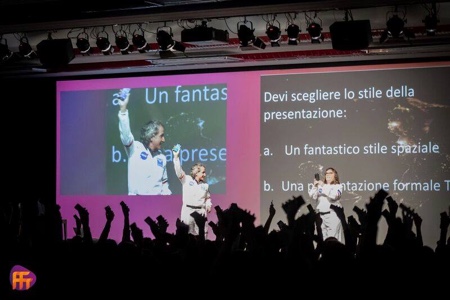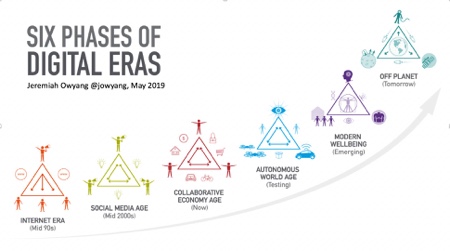
Yes, I walked onto the stage for the closing plenary at the Festival del Fundraising wearing an astronaut suit (that included a GivingTuesday sticker), to the theme of 2001 Space Odyssey, speaking Italian (poorly), with Marcelo Iniarra (creative concept was his idea) and shared some insights about the new ecosystem for fundraisers.
I am very grateful to Valerio Melandri who is the director of the festival for inviting me to participate as well as facilitate a maser class on modern wellbeing based on my book. And, also Selene Nicodemo, who made a lot of logistical accommodations. And, also to Marcele Iniarra for his creativity.
Now to recap some thoughts about what we presented and insights generated upon reflection.
The New Ecosystem
Marcelo explained how the ecosystem is evolving, pointing out big trends like the rise of Millennials and Gen-Z, highlighting one of the most inspiring social changemakers like Greta. He shared a lot of inspiring examples happening right now of how nonprofits have adapted and had big wins leveraging digital. He also touched on what skills and mindsets fundraisers need to adopt, including using Behavioral Economics as discussed in the book Change for Good.
One of the big questions and interactive components for the audience to ponder was an earlier iteration of Stephen George’s Fundraiser DNA. Are these aspects of the DNA from 2003 still the same?
- Fundraiser DNA
- Creativity
- Communication
- Financial Skills
- Passion
Digital Eras: The Next Frontiers – Modern Wellbeing and AI

This diagram is from Jeremiah Owyang, a greater thinker in Silicon Valley who looks at how digital eras impact business and society. This roadmap illustrates six different digital areas, beginning with the rise of the Web/Internet. The second era – social media/mobile or what many fundraisers call digital fundraising and what I wrote about in my first book, Networked Nonprofit, published a decade ago.
Marcelo was sharing much of what is currently happening and especially inspiring examples of how to apply the new skills. My talk was focused on the upcoming digital eras including AI and Modern Wellbeing. We are still in the early stages here, so we only have a few inspiring examples of AI-Driven Fundraising. . There is a lot more on the program implementation side, especially with recent incentives like the Google AI for Social Good Challenge.
I keep coming back to a decade old quote from Clay Shirky, “When the technology becomes boring, it becomes socially interesting.” We need to get to that point of more adoption. And that’s where I’ve spent the last 25 years of my nonprofit tech career, finding the technology interesting many years before we see it on the ground non profit adoption.
The Fifth Era: Automation – Robots, Bots, and Algorithms
I spoke about how the technology is evolving and future implications. It is very important as we approach this next technical era, that we don’t put on blinders. We need to look at how the technology is impacting our organizations and the people we serve. I also shared some current examples of what early adopters are doing both the fundraising niche and for program delivery.
AI-Driven fundraising key benefit is the ability to scale 1:1 engagement that now is primarily reserved for major donors. And, while automation has enabled early adopter fundraisers with the right database tools to pinpoint donor segments and customize communication, it is not the same thing as 1:1 engagement at scale. AI-Driven fundraising has the ability to scale customized donor interaction at scale. When you think about combination of AI-Driven fundraising and networks, the potential is mind blowing.
However, if only focused on the ROI benefit – you lose some of that potential because it lead to prospecting over keeping current donors engaged. We must embrace the concept of ‘CoBoting” is not part of the strategy. (CoBoting is using AI to free up human time from manual and tedious process and focus on the truly human abilities like donor engagement, creativity, etc).
Like any technology, there is both the benefits and the dark side. And, because evil Robots have been part of our popular culture many years, it may be easy to imagine some of the scary scenarios (which in same cases are happening today and seem to lifted right out of science fiction).
More importantly, some of the “evil,” while less dramatic is already here. This includes “algorithmic discrimination” Another issue is that real people need to be involved in the design of the AI technologies, not just the techies.
Fundraisers are looking at how to use the AI-Driven fundraising tools (early adopters at least) to improve ROI. And, while that is a benefit, there is a bigger picture or ecosystem view that is required. Lucy Bernholz has made this point.
The real question for nonprofits and foundations is not HOW will they use AI, but how is AI being used within the ecosystem within which they work and how must they respond.
How do we get to the big picture, bird’s eye view of this in an inspiring way? From IDEO, it is a moment for design thinking and innovation. “A moment for us to imagine the kind of future we want to see. What might it feel like?” This is hard for nonprofits to do who are focused on how can they raise more money with a new shiny object.
I just loved this article that imagines how AI can build capacity for skills like human empathy, creativity, self-awareness, and cross cultural communication. Wouldn’t this make a fundraiser more successful (in addition to that automated database?)
Lots to think about here. I am grateful to have thinking time with Allison Fine, supported by the Gates Foundation, to research and write about how AI can scale generosity. So, stayed tuned.

Leave a Reply